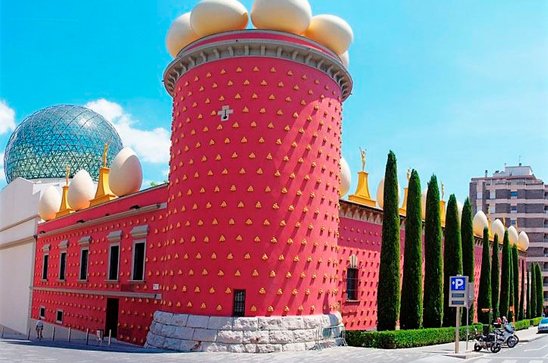DALÍ THEATER-MUSEUM
The world’s largest surreal object
The Dalí Theater-Museum, opened in 1974, stands on the remains of the old Municipal Theater of Figueres and is considered the last great work of Salvador Dalí. Everything in it was conceived and designed by the artist, in order to offer visitors a true experience and immerse them in a captivating and unique world.
The Dalí Theater-Museum collection allows the viewer to capture the artistic career of Salvador Dalí (1904-1989) through the widest range of works. The rooms tour allows to observe his first artistic experiences, surrealism, nuclear mysticism and a passion for science until he reaches the works of recent years.
Visit museum represents a unique experience to observe, live and enjoy the work and thought of the genius. As Dalí himself explained: “It is evident that there are other worlds, that’s for sure; but, as I have said many times, those other worlds are in ours, they reside on earth and precisely in the centre of the dome of the Museum Dalí, where the whole new unsuspected and amazing world of surrealism is”.
Origins and creation
The beginings of the Theater-Museum project are in the early sixties. Ramon Guardiola, then mayor of Figueres, asks Salvador Dalí to donate a work for the Empordà Museum. Dalí’s answer is immediate, in Figueres he will not only give him a work, but an entire museum:
“Where, if not in my city, should the most extravagant and solid of my work last, where else? The Municipal Theater, what was left of it, seemed very appropriate to me, and for three reasons: the first, because I am a eminently theatrical painter, the second, because the theater is just in front of the church where I was baptized, and the third, because it was precisely in the hall of the theater where I exhibited my first sample of painting.”
The Gala-Salvador Dalí Foundation collections include all kinds of art works: painting, drawing, sculpture, engraving, installation, hologram, stereoscopy, photography, etc. Of these, some 1500 are exhibited at the Dalí Theater-Museum in Figueres.
Three well-differentiated museum spaces offer visitors a free and personal tour of Dalí Theater-Museum rooms:
1. The Theater-Museum, properly speaking, formed by the old burned-out municipal theatre and converted into a Theater-Museum based on the criteria and design of Salvador Dalí himself. This set of spaces forms a unique artistic object where each element is an inseparable part of the whole.
2. The rooms, the result of the progressive extensions of the Theater-Museum, where Dalí’s personal intervention is testimonial or non-existent. These rooms display numerous works from the artist’s legacy, stereoscopic works and installations, anamorphisms, as well as new acquisitions made by the Foundation.
3. The Dalí · Jewels showrooms, inaugurated in 2001, where the thirty-seven gold and precious stone jewels from the old Owen Cheatham collection are presented, two jewels made later, and the previous designs made by the painter.
The Dalí Theater-Museum contains a wide range of works that describe the artistic career of the Empordà painter, from his first artistic experiences-impressionism, futurism, cubism, etc …- and his surrealist creations, to the creations of the last years of his life. Some of the most outstanding works on display are Self-portrait with l’Humanité (1923), Port Alguer (1924), The spectre of sex appeal (1932), Portrait of Gala with two lamb ribs balanced on his shoulder (1933 ), Soft Self-Portrait with Fried Bacon (1941), Poetry of America-The Cosmic Athletes (1943), Galarina (1944-45), The Basket of Bread (1945), Atomic Leda (1949) and Galatea of the Spheres (1952) , among many others.
It is also worth noting the set of works made by the artist with the express purpose of being permanently exhibited in the museum, works ranging from paintings and sculptures to complex monumental installations. In this group, the Mae West room, the Palacio del Viento room, the Monument to Francesc Pujols and the rainy Cadillac stand out.
In addition, in some Theater-Museum spaces, we can see creations by John de Andrea, Wolf Vostell, Meifrén and Ernst Fuchs. Since Salvador Dalí’s death in 1989, you can also visit the crypt with his tomb, located in the centre of the museum; a space that was remodelled in 1997 to expose a collection of gold jewellery designed by the artist.


